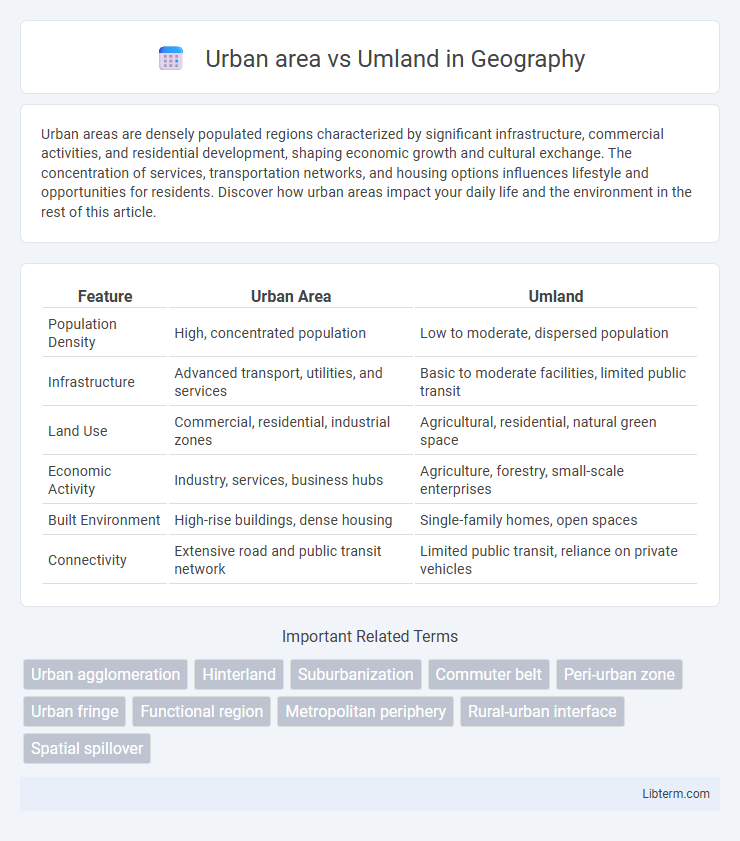Urban areas are densely populated regions characterized by significant infrastructure, commercial activities, and residential development, shaping economic growth and cultural exchange. The concentration of services, transportation networks, and housing options influences lifestyle and opportunities for residents. Discover how urban areas impact your daily life and the environment in the rest of this article.
Table of Comparison
| Feature | Urban Area | Umland |
|---|---|---|
| Population Density | High, concentrated population | Low to moderate, dispersed population |
| Infrastructure | Advanced transport, utilities, and services | Basic to moderate facilities, limited public transit |
| Land Use | Commercial, residential, industrial zones | Agricultural, residential, natural green space |
| Economic Activity | Industry, services, business hubs | Agriculture, forestry, small-scale enterprises |
| Built Environment | High-rise buildings, dense housing | Single-family homes, open spaces |
| Connectivity | Extensive road and public transit network | Limited public transit, reliance on private vehicles |
Introduction to Urban Areas and Umland
Urban areas are densely populated regions characterized by extensive infrastructure, commercial activity, and residential buildings, often serving as economic and cultural hubs. Umland refers to the surrounding suburban or rural zones that support the urban core through commuter connections, agricultural space, and natural landscapes. Understanding the relationship between urban areas and umland is crucial for regional planning, transportation development, and sustainable growth management.
Defining Urban Areas: Key Characteristics
Urban areas are characterized by high population density, extensive infrastructure, and multifunctional land use, including residential, commercial, and industrial zones. These regions exhibit continuous built environments with transportation networks, utilities, and public services that support concentrated human activities. In contrast, the umland typically surrounds urban cores and features lower population density with a mix of agricultural land, suburban development, and natural landscapes.
Understanding Umland: What Sets It Apart?
Umland refers to the peripheral regions surrounding an urban area, characterized by lower population density and more open space compared to densely built-up urban centers. Unlike urban areas, which feature concentrated residential, commercial, and industrial development, the Umland often includes suburban communities, agricultural land, and natural landscapes, serving as a buffer zone that supports urban functionality. Understanding the Umland is crucial for regional planning, as it influences commuting patterns, economic interactions, and environmental management in the broader metropolitan context.
Population Density: Urban vs Umland Comparison
Urban areas exhibit significantly higher population densities, often exceeding 10,000 people per square kilometer, compared to surrounding umland regions where densities typically range between 500 and 2,000 people per square kilometer. This stark contrast reflects concentrated residential, commercial, and infrastructural development within urban cores versus more dispersed, lower-density housing and agricultural uses in umland zones. Population density differences impact transportation planning, resource allocation, and environmental management across metropolitan regions.
Economic Activities in Urban Areas and Umland
Urban areas concentrate diverse economic activities including finance, technology, manufacturing, and services due to high population density and infrastructure. Umland regions primarily support agriculture, resource extraction, and light industry, benefiting from proximity to urban markets and transportation networks. Economic interdependence between urban centers and surrounding umland fosters regional growth through labor mobility, supply chains, and market access.
Infrastructure and Accessibility Differences
Urban areas feature dense infrastructure networks with extensive public transportation systems, including subways, buses, and bike-sharing programs, enhancing accessibility and reducing travel times. Umland regions typically exhibit lower infrastructure density, relying more on personal vehicles due to limited public transit options and longer travel distances. Differences in road quality, connectivity, and availability of services significantly impact daily accessibility and regional development in both zones.
Environmental Impacts: Urbanization vs Umland
Urban areas experience significant environmental impacts such as increased air pollution, heat island effects, and habitat fragmentation due to dense infrastructure and high vehicle emissions. In contrast, the umland, or surrounding rural areas, often face agricultural runoff, deforestation, and biodiversity loss as land is converted for farming and resource extraction. Balancing urban growth with sustainable practices in the umland is critical to minimizing overall ecosystem degradation and promoting regional environmental health.
Social Dynamics and Community Life
Urban areas exhibit high population density, fostering diverse social interactions and vibrant community life characterized by numerous cultural institutions, events, and services. Umland regions, typically less densely populated, emphasize close-knit social networks, stronger neighborly ties, and community involvement rooted in shared local traditions and outdoor activities. The contrast in social dynamics between urban centers and their surrounding umland shapes distinct patterns of social cohesion, participation, and lifestyle preferences.
Urban Expansion and Umland Transformation
Urban expansion drives the growth of densely populated areas, characterized by increased infrastructure, housing developments, and commercial zones. Umland transformation involves the gradual shift of surrounding rural or semi-rural regions into suburban landscapes, marked by land-use changes, agricultural decline, and new transportation networks. These processes reshape regional spatial dynamics, influencing economic activities, environmental sustainability, and demographic patterns.
Future Trends: Integrating Urban Areas and Umland
Future trends in urban development emphasize seamless integration between urban areas and surrounding umland to promote sustainable growth and resource efficiency. Enhanced transportation networks and smart infrastructure facilitate better connectivity, reducing urban sprawl and supporting balanced economic development. Innovations in land-use planning and digital technologies enable coordinated governance, ensuring that urban expansion harmonizes with agricultural preservation and natural ecosystems.
Urban area Infographic

 libterm.com
libterm.com